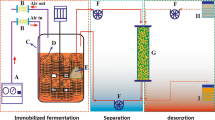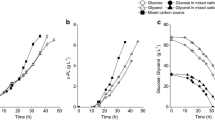Abstract
The production of ε-poly-l-lysine (ε-PL) by Streptomyces sp. M-Z18 from glycerol was investigated in a 5-L jar-fermenter. Batch fermentations by Streptomyces sp. M-Z18 at various pH values ranging from 3.5 to 4.5 were studied. Based on the analysis of the time course of specific cell growth rate and specific ε-PL formation rate, a novel two-stage pH control strategy was developed to improve ε-PL production by shifting the culture pH from 3.5 to 3.8 after 36 h of cultivation. By applying the strategy, the maximal ε-PL concentration and productivity had a significant improvement and reached 9.13 g L−1 and 4.76 g L−1 day−1, respectively, compared with those in one-stage pH control process where the pH value is controlled at 3.5 (7.83 g L−1 and 3.13 g L−1 day−1). Fed-batch fermentation with two-stage pH control strategy was also applied to produce ε-PL; final ε-PL concentration of 30.11 g L−1 was obtained, being 3.3-fold greater than that of batch fermentation. To our knowledge, it is the first report on production of ε-PL from glycerol in fermenter scale and achievement of high ε-PL production with two-stage pH control strategy.





Similar content being viewed by others
References
Hiraki J (2000) ε-Polylysine, its development and utilization. Fine Chem 29:18–25
Shima S, Matsuoka H, Iwamoto T, Sakai H (1984) Antimicrobial action of ε-poly-l-lysine. J Antibiot 37:1449–1455
Shih IL, Van YT, Shen MH (2004) Biomedical applications of chemically and microbiologically synthesized poly(glutamic acid) and poly(lysine). Med Chem 4:179–188
Yoshida T, Nagasawa T (2003) ε-Poly-l-lysine: microbial production, biodegradation and application potential. Appl Microbiol Biotechnol 62:766–772
Neda K, Sakurai T, Takahashi M, Ashiuchi M, Ohgushi M (1999) Two-generation reproduction study with teratology test of ε-poly-l-lysine by dietary administration in rats. Jpn Pharmacol Ther 27:1139–1159
Shih IL, Shen MH, Van YT (2006) Microbial synthesis of poly (l-lysine) and its various applications. Bioresour Technol 97:1148–1159
Kahar P, Iwata T, Hiraki J, Park EY, Okabe M (2001) Enhancement of ε-polylysine production by Streptomyces albulus strain 410 using pH control. J Biosci Bioeng 91:190–194
Shih IL, Shen MH (2006) Optimization of cell growth and poly(ε-lysine) production in batch and fed-batch cultures by Streptomyces albulus IFO 14147. Process Biochem 41:1644–1649
Zhang Y, Feng XH, Xu H, Yao Z, Ouyang PK (2010) ε-Poly-l-lysine production by immobilized cells of Kitasatospora sp. MY 5–36 in repeated fed-batch cultures. Bioresour Technol 101:5523–5527
da Silva GP, Mack M, Contiero J (2009) Glycerol: a promising and abundant carbon source for industrial microbiology. Biotechnol Adv 27:30–39
Raj SM, Rathnasingh C, Jo JE, Park S (2008) Production of 3-hydroxyl-propionic acid from glycerol by a novel recombinant Escherichia coli BL21 strain. Process Biochem 43:1440–1446
Petrov K, Petrova P (2009) High production of 2, 3-butanediol from glycerol by Klebsiella pneumoniae G31. Appl Microbiol Biotechnol 84:659–665
Menzel K, Zeng AP, Deckwer WD (1997) High concentration and productivity of 1, 3-propanediol from continuous fermentation of glycerol by Klebsiella pneumoniae. Enzym Microb Technol 20:82–86
Mothes G, Schnorpfeil C, Ackermann JU (2007) Production of PHB from crude glycerol. Eng Life Sci 7:475–479
Lee PC, Lee SY, Chang HN (2010) Kinetic study on succinic acid and acetic acid formation during continuous cultures of Anaerobiospirillum succiniciproducens grown on glycerol. Bioprocess Biosyst Eng 33:465–471
Shima S, Sakai H (1977) Polylysine produced by Streptomyces. Agric Biol Chem 41:1807–1809
Bankar SB, Singhal RS (2010) Optimization of poly-ε-lysine production by Streptomyces noursei NRRL 5126. Bioresour Technol 101:8370–8375
Chen XS, Tang L, Li S, Liao LJ, Zhang JH, Mao ZG (2011) Optimization of medium for enhancement of ε-Poly-l-Lysine production by Streptomyces sp. M-Z18 with glycerol as carbon source. Bioresour Technol 102:1727–1732
Nishikawa M, Ogawa K (2002) Distribution of microbes producing antimicrobial ε-poly-l-lysine polymers in soil microflora determined by a novel method. Appl Environ Microbiol 68:3575–3581
Hiraki J, Masakazu H, Hiroshi M, Yoshikazu I (1998) Improved ε-poly-l-lysine production of an S-(2-aminoethyl)-l-cysteine resistant mutant of Streptomyces albulus. Seibutsukogaku 76:487–493
Naviglio D, Romano R, Pizzolongo F, Santini A, De Vito A, Schiavo L, Nota G, Musso SS (2007) Rapid determination of esterified glycerol and glycerides in triglyceride fats and oils by means of periodate method after transesterification. Food Chem 102:399–406
AOAC International (formerly the Association of Official Analytical Chemists) (1995). Official Methods of Analysis Arlington, AOAC International, VA
Ouyang J, Xu H, Li S, Zhu HY, Chen WW, Zhou J, Wu Q, Xu L, Ouyang PK (2006) Production of ε-poly-l-lysine by newly isolated Kitasatospora sp. PL6-3. Biotechnol J 1:1459–1463
Yamanaka K, Kito N, Imokawa Y, Maruyama C, Utagawa T, Hamano Y (2010) Mechanism of ε-Poly-l-Lysine production and accumulation revealed by identification and analysis of an ε-Poly-l-Lysine-Degrading. Appl Environ Microbiol 76:5669–5675
Author information
Authors and Affiliations
Corresponding authors
Rights and permissions
About this article
Cite this article
Chen, XS., Li, S., Liao, LJ. et al. Production of ε-poly-l-lysine using a novel two-stage pH control strategy by Streptomyces sp. M-Z18 from glycerol. Bioprocess Biosyst Eng 34, 561–567 (2011). https://doi.org/10.1007/s00449-010-0505-8
Received:
Accepted:
Published:
Issue Date:
DOI: https://doi.org/10.1007/s00449-010-0505-8




